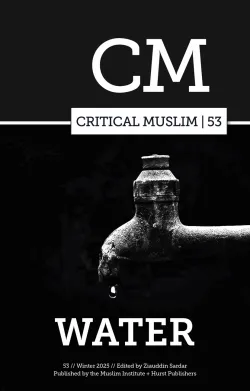Ready or Not
‘Welcome to PostnormalTimes’.The first words inviting visitors intoThe Postnormal Times MADANI Exhibition in Kuala Lumpur (26 May–10 November 2024) are the same as the title of the 2010 paper by Ziauddin Sardar. The seminal text initiated the development of a future oriented approach to address the changing nature of change. Postnormal times thinking sees the speed, scale, scope, and simultaneity (4Ss) of our globalised, digital, networked environment drive increasingly complex, contradictory, and chaotic (3Cs) accelerating change. This perspective situates our era between the no longer and the not yet.
Uncertainty and ignorance follow, characteristically affecting actions and choices available to us in our personal or spiritual lives, in our lives as citizens, and in policymaking too. To orient and move forward in such an enigmatic present, managerial and solutionist mindsets must be shed.The real task in front of us is to jointly navigate the massive challenges people, communities, nations, and organisations face; and to negotiate our way towards a more equitable and just tomorrow.To continue as normal is to put ourselves, our communities, cultures, and the planet itself at peril.We will have to count on diversity, on values, and on imagination if we are to make it through.
The exhibition is divided in three parts to bring these ideas across in an accessible and engaging manner. The opening section highlights the confounding realities of postnormal phenomena, some of the major issues we face today: from misinformation and the AI revolution to genetic manipulation, climate catastrophe, the impacts of the COVID pandemic, and degrading governance. Next, the exhibition offers a lens through which we may more clearly discern and understand what is really going with a view on enabling mutual work towards a preferable state of affairs. The third and final section of the show presents how postnormal times thinking informs the values driven policy of the current government of Malaysia, the SCRIPT/MADANI framework and plan for reform, a compass for action in the present based on six central values: sustainability, care and compassion, respect, innovation, prosperity, and trust.
The Postnormal Times MADANI Exhibition,
curated by Ziauddin Sardar and C Scott Jordan; organised by the Centre for Postnormal Policy and Futures Studies; designed by Effusion LLP; installed by Rock, Paper, Scissors Sdn Bhd.
Berjaya Times Square, Kuala Lumpur 26 May 2024 onwards
With national policy – literally – in the spotlight at this exhibition, it is suitable that the show was opened, on 26 May, with a viewing by Malaysia’s Prime Minister Dato’ Seri Anwar Ibrahim. Along with him came a big flock of journalists from local, regional, and international media outlets. The Malaysian leader is not just a champion of postnormal times thinking, he is actively implementing it, putting forward SCRIPT/MADANI as a national vision and a navigational plan. At the press conference that followed his guided tour, he called for as many people as possible to see the exhibition and to get talking about our changing world.
The show site is the Berjaya Times Square complex in central Kuala Lumpur. It is an ambitious production, a massive expansion on previous exhibitions produced by the Centre for Postnormal Policy and Futures Studies (CPPFS). A tremendous amount of work has gone into its realisation, beginning with the development and elaboration of the postnormal times approach itself in papers, workshops, and polylogues by members of the CPPFs and a broader network of postnormal thinkers and practitioners around the globe.Then followed the labour of translating this work to an attractive and fathomable exhibition format for an extended peer community that includes all sections of the diverse Malaysian population as well as policymakers and intellectuals with a taste for forward thinking.
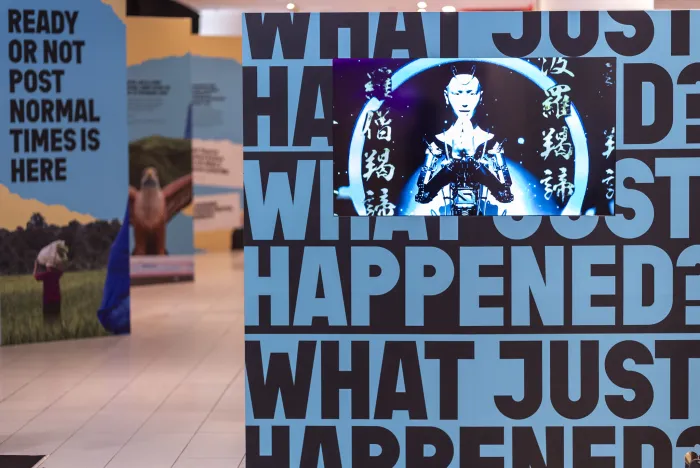
In September 2023, a pre-figuration of the current exhibition was presented at the KL Jazz & Art Centre, a modest venue with ample gallery wall and floor space and an atmospheric dark basement.With a well- developed popular science approach in a contemporary arts venue, this ‘not your normal exhibition’ already was impressive in its detail, contextualisation, content choices, and clarity of design. So impressive that the crew received encouragements to scale up; six months later they were ready to present an even more striking new exhibition at the tenth floor of Berjaya Times Square. Every section of the plentiful current show uses multiple video and infographic screens.Visitors are invited to interact with the content and displays. In the ‘Tunnel of Truth’ in the Post-Truth section, they can walk through a series of tight beam sound showers, a jumble of historic and current affairs sound bites. Another audio installation draws attention to how misinformation takes hold in the echo chambers of social and mainstream media.Visitors put their head into one of two small cubes filled with repetitive audio for an embodied sensory experience of the reverberations of beliefs and opinions in our filter bubbles. One corner resembles a hall of mirrors in which images of the self are distorted. In the area dedicated to AI, there is a game for guessing who in a series of portraits is the real human being and who is an AI creation.
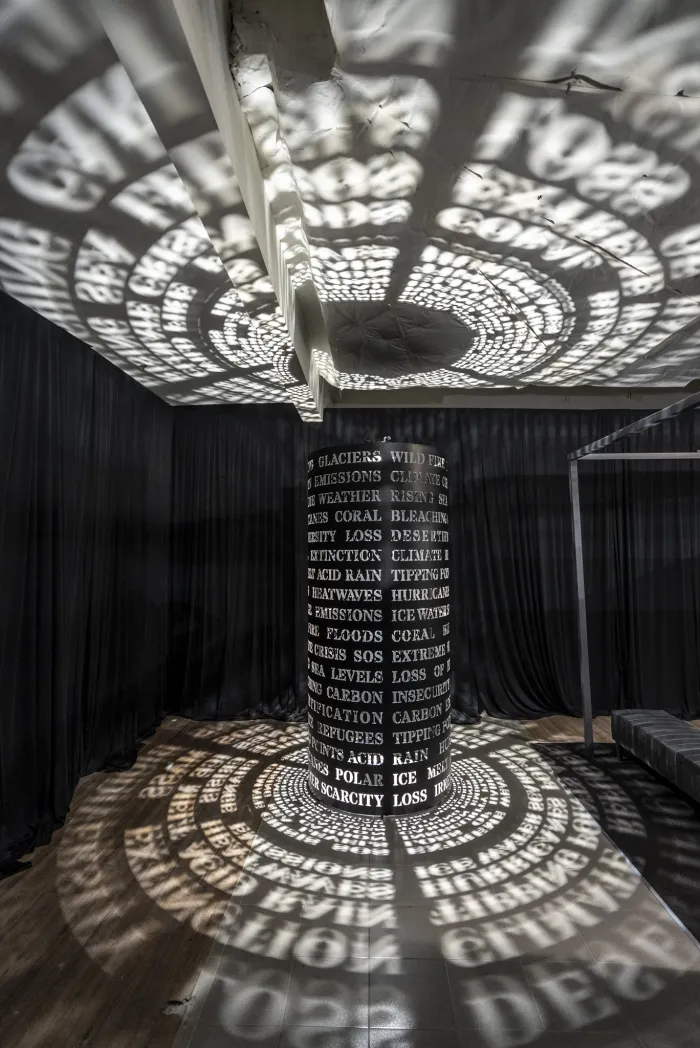
Nearby, a smart CCTV display shows any visitor approaching the monitor, a live stream of their movement back to them, against a checkered background repeating the message ‘Smile! You are being judged’. Further into the visit, in the theory section, viewers can add their own answers to the question ‘what are you uncertain about?’ to one of the exhibition panels.The Prime Minister wrote ‘the economy’, someone put simply ‘my life’, one thinks of finding love another of finding employment. Such is the variety of the postnormal condition.
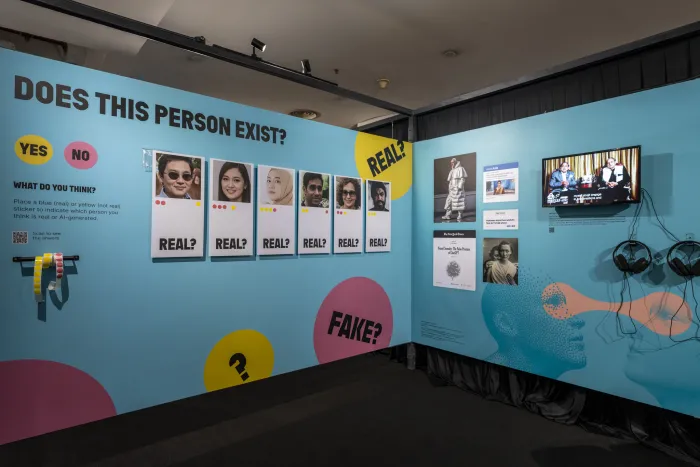
It is a good thing that with all the effort and attention that has gone into creating this exhibition, it remains unfinished. Not that there are notable loose ends in what has been put together. No stone has been left unturned in the treatment of all the various elements that represent issues and phenomena of our intermediate era and how they might be understood or addressed. Each idea is illustrated with salient examples as well as explanatory texts. Still, by itself the material of the Postnormal Times MADANI Exhibition is unfulfilled. Only the visitor can complete the exhibition. As such, this expo is an open work in the true sense that Umberto Eco had in mind.The curators, designers, and production team put in a strong and multifaceted creative intention.The makers’ intent by itself integrates multiple meanings and levels of granularity. Crucially, it is not final, it does not determine the one and only true meaning of the content or the form. It can only land with the readings and interpretations of visitors. And surely this too is intentional.
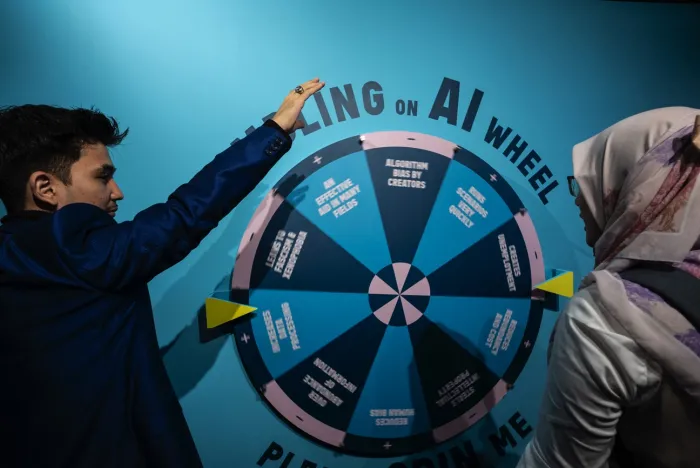
Given the ambiguities of the subject matter, exemplified amongst others by an ‘AI gambling wheel’ that has two pointers which always land on one positive and one negative potential impact of AI, it is appropriate that the exhibition leaves space for viewers to find their own perspectives on (and responses to) the topics at hand.There is ample opportunity for the viewerto choose their own way through the different sections and subsections. For some the physical wayfinding may be somewhat disconcerting, not as perturbing as navigating postnormal reality, but certainly an experiential reminder of its challenges. At the main entrance to the exhibition a well- crafted signalisation points the way. Once inside, here and there arrows indicate the general direction for following the narrative. Having visited or simply crossed the exhibition multiple times, I never chose the same trajectory. I often found myself questioning where to go next, how much to take in before moving on, what to skip and what to revisit.
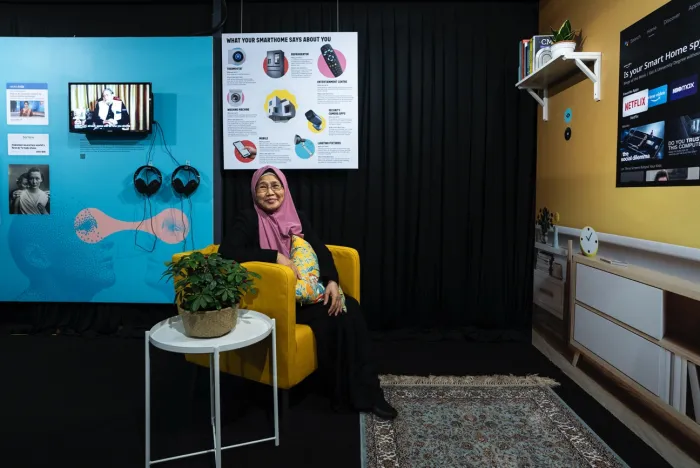
If you follow every path the curators and designers have provided, it will take you far.You can go find the books and magazines on display here and take them home, read and watch the referenced news features online, or take in the full text of the SCRIPT/MADANI document. Not every visitor will dive in so deep, and every visitor will make something different of what is shared in this open work. It matters if the viewer is the PM or an MP, one of a group of Islamic futures students accompanied by their teachers, a gallery assistant, a futures consultant, a policy analyst, or a housewife, the minister of education or a member of her cabinet. This exhibition is not the same if you are a resident of Kuala Lumpur - a KLite, a regional visitor or an international traveller, a tourist who came across the flashy promo clip elsewhere in the Berjaya Times Square complex, or someone working nearby just using their break for a quick visit. Certainly, the way I see this exhibition will not resemble any of theirs. My perspective is that of a privileged witness with a lot of background in postnormal times theory and practice. Having hosted the CPPFS in my hometown Antwerp, as co-curator and fellow exhibitor of the group exhibition in the Museum of Contemporary Art of Antwerp entitled A Temporary Futures Institute in the year 2017, that same year I became a senior fellow of the CPPFS. Later, part of the postnormal exhibit from Antwerp travelled to Barcelona where I joined a group of CPPFS fellows for the Blanquerna Summer School. I have written about postnormal times, given talks on science days in Belgium, and facilitated and contributed to workshops in Brussels, London, Istanbul, Sarajevo, and Kuala Lumpur. In other words, I know the challenges of bringing across to different audiences the essence and nuances of the postnormal times approach.
This biases my perspective towards the popular science aspects of the effort that was put into the Postnormal Times MADANI exhibition. From that point of view the well-crafted show is exciting.The question‘so what is going on’ central to the second section of the exhibition is not an easy one. It leads essentially to a presentation of postnormal times theory’s key concepts.The transition into more notional reflection after the numerous thought-provoking examples of postnormal realities in the first section is smooth. In a large more open space where the visitor can recover from the myriads of impressions and sensations in the colourful and fast paced ‘what just happened’ section, a large projection slows one’s racing thoughts down.This room is filled with the white light of the background of a many metres long projection with soft black and white images of swans, elephants, and jelly fish quietly gliding across the wall. The big letters of keywords, the single sentence prompts, and the explanatory texts or audio have been left aside. It is a relief to the by now overstimulated senses.
The wall across the spacious projection is dotted with a series of small frames in the signature aqua colour that saturates most other parts of the expo. The most important question one reads here is ‘what are we not seeing’.The visitor must lift the aqua frames covering short explanatory texts to reveal what might be missed when thinking about the Covid-19 pandemic, the war in Israel-Palestine, or pollution, to name just a few.The meaning of the three animals in the projection is explained with these provocations. Only after crossing this space, we return to a multitude of examples and explanations to illustrate postnormal theory.The questions ‘what is the elephant in the room’, ‘what black swans evade our focused gaze’, and ‘what chaotic jellyfish are about to bloom’ feature in an installation that hides typical exemplars inside. Then, in no particular order, the visitor can explore instances of postnormal change, demonstrating how speed scope, scale, and simultaneity bring about the forces of contradictions, complexity, and chaos, leading to ever deeper ignorance and uncertainty.At the end of this section a series of timelines compares how all these elements taken together define postnormal times as distinct from classic, modern or postmodern times. Finally, a panel asks ‘where now’. I can barely imagine what other viewers responses to the open question ‘what future would you like to create’ might be or whether at this point they would even be inclined to address it.
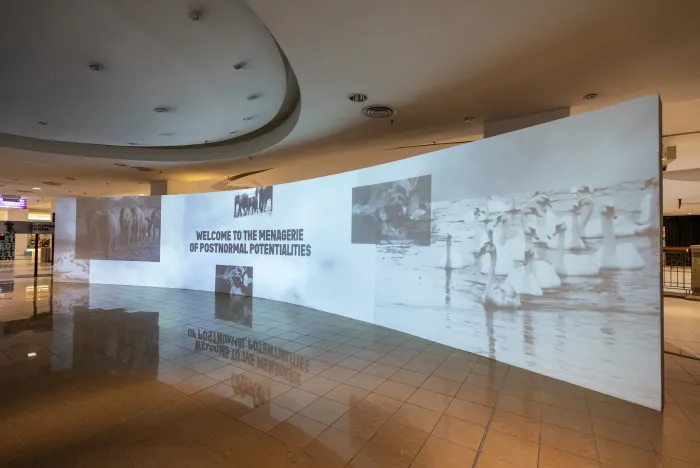
Ultimately this exhibition offers more than popular science or a diagnosis of our time. It shouldn’t be seen separately from the specific political context for which it was developed. The contemporary affairs content, the abundance of examples of the weirding of our world, pressing matters all, underpin the idea that a response is indeed required. SCRIPT/ MADANI is one such response, a strategic framework for policy in the face of all the urgent matters that Malaysia must address. This policy programme relies on the specificities of Malaysian society and its diverse cultures with trust in a set of key values that are undeniably virtuous.
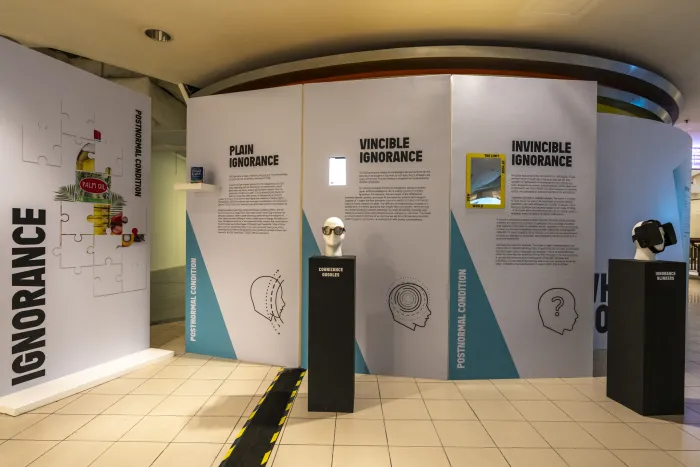
The addition of this section casts a whole other light on the show and the makers’ intentions.The entire effort now can be seen not only as science communication but also as a form of marketing.The banners lined up between the theory section and the policy section, featuring images of the national leader, Malaysian environments and people, are unmistakable. There is no hidden agenda, the partisanship is explicit. In that context the question begs to be asked if besides being informative, educational, and triggering; this exhibition is persuasive too. Surely, this depends again on the starting points of the visitors. It would be surprising if a visit to this exhibition would sway members of the conservative opposition to accept the merits of the more progressive take on the needs of Malaysians and the nation that can be found in the discussions of the SCRIPT/MADANI section. A more detached viewer on the other hand, might be interested in understanding not just from the short introductory text by the Prime Minister in the brochure accompanying the show, but inside the dynamic three-dimensional affair itself, how postnormal thinking got to be embedded in the current government’s programme. Is this something that could be done in my own country too, I wonder.What would be required? How do concrete policies engage in navigating postnormal times? Perhaps this section might also have benefited from the same kinds of examples of specific measures, actions, and behaviours that are omni-present in the previous sections. Even so, the show strikes the difficult but important balance between persuasion and openness to interpretation well by setting up the presentation of the MADANI values to include the voices and imaginaries of artists rather than politicians.
As I participated in the events and activities at the KL Jazz & Art Centre in the fall of 2023, what stood out to me was exactly the absence of artists. The significance of the roles of artists and their creations in postnormal times has been highlighted in more than a few pieces of postnormal times literature. These creatives can reframe, re-orient, trigger learning and un-learning, impress and inspire. It was good to see that in the Postnormal Times MADANI exhibition six Malaysian artists from different backgrounds and regions contribute to evoke the values that are the drivers for the SCRIPT/MADANI framework. Of course, the artists do not exactly describe policy aims, criteria, and measures in the domains of economy, institutions, education, social, cultural, urban, and rural sectors. Instead, they provide an open-ended introduction to the core values of the programme from their lived experience.Their work is far removed from the slick and often superficial copywriting of more common formats for political messages and campaigns.
This section wants to convince but it also provides some surprising re-interpretations of the values that it presents.The artists’ representations of the six drivers in six separate booths that make up the last stretch of the show, serve to implicitly bring across the framework’s openness and preserve the shows character as an open work.The first booth features the multi-disciplinary artist Anju, who treats ‘sustainability’ with attention for the throw-away culture of our time.The small paintings on the walls, invite a closer look to reveal they have been composed with items collected from trash.To look more closely at these elegant yet slightly disturbing pieces, the viewer must walk underneath a collection of plastic garbage items dangling from the ceiling, seemingly having risen from the bright orange bin in the centre of the space. The accompanying wall text casts sustainability as a process, a collective effort that pertains to rural and urban communities and people and their families as well as the natural environment. In the next booth, the artist Fakrhul Zaman presents minimal collages and sculptures, small toy-sized objects casually arranged on a table and shelves to address the second driver of ‘care and compassion’. This is a friendly piece, the small imaginary creatures on the shelves and table have a childlike naïve quality that softens the heart. Here it is easy to feel the love for others unlike ourselves and for nature that is so essential to how we live and go forward together.
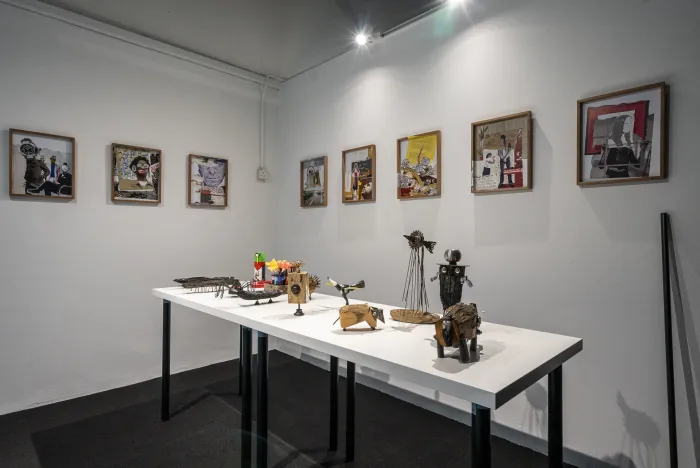
The highly original description of ‘respect’ in the third booth is eye- opening and well accompanied by graphic designer Stephen Menon’s set of stirring prints with strong human figures against evocative backgrounds and by the artists thoughts on the relationship between self-respect and empowerment. Next, Peter Jambai Anak Albert Bangau shows a video of a single digital artwork in the booth that is dedicated to ‘innovation’. Here, the MADANI explainer connects the idea of conscious design to planning and creativity.The artist in turn examines technological progress with a critical eye. He proposes a video game in which the player’s decisions guide the evolution from one civilisational level to the next. The piece itself is presented as a small projection in an otherwise empty booth. No more than the growing, evolving silhouette of a plant, it almost disappears against the background. The ‘prosperity’ booth with sculptor Liu Cheng Hua’s bamboo structures covered in gold paint is quite the opposite. It is heavy with the ‘Golden Shafts’ that reference shaft mining techniques, pointing at the extractive nature of mining and the impact of globalisation. The final driver, ‘trust’, is presented with a well-conceived piece by the artist Azizan Paiman. It stands in stark contrast to the post-truth section that opens the exhibition.The accompanying text describes trust as a vow of earthly, divine, and spiritual moral responsibility, highlighting also that the Malaysian notion adds faith and the principle of reciprocity to this interpretation.We are not only morally responsible for building trust, but also for honouring the trust put upon us.The artist’s modest glass cabinet that encases unreachable quotes related to trust, serves as a metaphor for the delicate balance between trust and scepticism in political leadership, is a worthy endpoint for the show.
The SCRIPT/MADANI section opens with a banner stating ‘ready or not, postnormal times is here’. Any visitor of the exhibition will have plenty of material to ponder the question.
For me, impressed by the utterly self-referential nature of the inordinate breadth and depth of this exhibition and the staggering amounts of ideas, images, and content it presents, it was hard to answer with an unequivocal yes. Even more so because the exhibition’s physical setting adds a disturbing paradox. It takes place in the centre of one of the fastest growing metropolitan regions of Southeast Asia, itself bursting with colourful moving advertising panels, a consumerist feast with wares and goods on display everywhere, whether in street markets or in shiny, over- lit shopping malls.The show can be found on the tenth floor, right above one of the most prestigious of these malls, at the heart of the Berjaya Times Square complex. A few floors below is the largest indoor theme park in Malaysia, a five-storey bonanza including a roller coaster for the public’s entertainment and distraction.The exhibition has a view over the theme park. The entrance to the show is flanked by a wall sporting a huge Starbucks logo. To explore the nature of the troubles of our time in the midst of the trouble itself, with the background of deep drone and rattle of the attraction next door conducted through the concrete and steel bones of the building, and the screams emanating from the rides, sounding of both joy and fear, layer upon layer of overwhelming sensory overload, it is unclear if indeed we will be able to untangle ourselves from the path we are on and navigate through the imbroglio of our unique in-between era.
It is indeed an act of bravery that the curators of this exhibition, and leaders and policymakers who embrace a postnormal times approach, have put so much into guiding us towards the insight and intention we need for a glimmer of hope.
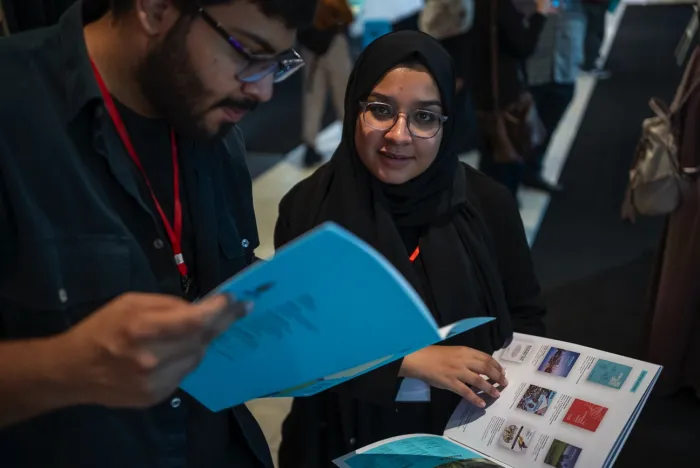
Citations
‘Welcome to Postnormal Times’, originally published in Futures 42 435- 444 (2010), is included in The Postnormal Times Reader, edited by Ziauddin Sardar (CPPFS/IIIT, London and Kuala Lumpur, 2019). A great deal of postnormal literature can be found in Postnormal Times Reader volume 2, edited by Ziauddin Sardar, Shamim Miah and C Scott Jordan (CPPFS/IIIT, London and Kuala Lumpur, 2024). Both volumes, as well the exhibition catalogue, can be downloaded from postnormaltim.es

